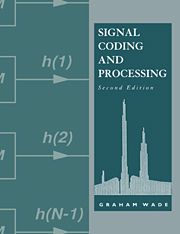Book contents
- Frontmatter
- Contents
- Preface
- Abbreviations
- 1 PCM signals and systems
- 2 Source coding
- 3 Channel coding
- 4 Digital filters
- 5 Discrete transforms
- Problems
- Appendix A Transposition of digital filters using signal flow graphs
- Appendix B Fixed-point arithmetic
- Appendix C C-routine for FIR filter design
- Appendix D C-routine for DIT in-place radix-2 FFT
- Appendix E C-routine for Meggitt decoder simulation
- References
- Index
3 - Channel coding
Published online by Cambridge University Press: 05 June 2012
- Frontmatter
- Contents
- Preface
- Abbreviations
- 1 PCM signals and systems
- 2 Source coding
- 3 Channel coding
- 4 Digital filters
- 5 Discrete transforms
- Problems
- Appendix A Transposition of digital filters using signal flow graphs
- Appendix B Fixed-point arithmetic
- Appendix C C-routine for FIR filter design
- Appendix D C-routine for DIT in-place radix-2 FFT
- Appendix E C-routine for Meggitt decoder simulation
- References
- Index
Summary
The broad objective of channel coding is to ‘match’ the source data to the transmission channel, and the coding techniques involved generally fall under the heading of either error control coding (ECC) or transmission coding. Scrambling techniques are often used to improve synchronization and can also be regarded as a form of channel coding.
Overview of ECC
Fig. 3.1 gives an overview of ECC techniques. Two main classes of error control are used to achieve an acceptable error rate at the receiver, namely, automatic repeat request (ARQ) and FEC. ARQ uses an error detecting code together with a feedback channel to initiate retransmission of any block received in error. It can be used where time delay is permissible, e.g. in data transmission. In contrast, FEC controls the received error rate via forward transmission only. In its simplest form, FEC amounts to error concealment, Fig. 3.2. Here, upon detection of a parity error the receiver could repeat the last most suitable word. Alternatively, after detection an isolated erroneous sample could be replaced by a linear interpolation between its two neighbours. The latter type of concealment is used on compact disc systems when an error correction code is overloaded, thereby avoiding sharp audio ‘clicks’. Concealment techniques are simple to implement, but have restricted applications. For example, they are not applicable to computer systems, or to systems where sample-to-sample correlation has already been exploited, e.g. DPCM systems.
- Type
- Chapter
- Information
- Signal Coding and Processing , pp. 106 - 224Publisher: Cambridge University PressPrint publication year: 1994



